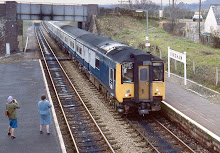Charles Holden is in my Pantheon of Gods. This unassuming Englishman developed an architecture programme that introduced Modernism to Britain, adapting and simplifying it to suit a culture that was still emotionally attached to the Arts & Crafts Movement, but creating masterworks that have performed beautifully for nearly 80 years:

His portfolio of new stations for the extension to the Piccadilly line on London's Underground is one of the most significant public works ever commissioned in Britain. Starting here, in the modest suburbs of Sudbury Town, Holden produced a pilot station to test his new thinking:

All of the overt Classicism was to be abandoned, replaced with simple buildings made of vernacular brick and glass in basic geometric shapes: cubes, cuboids and drums.

The old, dark caverns were to be a thing of the past, replaced with generous public spaces which let daylight flood in through vast windows -- which, at night, would become natural beacons, the warm, electric light signalling all around that here was the sanctuary of an inviting Underground station.

The prototype was a triumphant success: near-universally acclaimed, but also relatively economical to build (the flat roofs were made of concrete, the materials, while of very good quality, were as far as possible formed into standardised components). The rest of the stations followed:

In general they were architectural riffs on the same theme: they were made larger or smaller depending on the numbers of people who needed to use them (or on population predictions in some places, one or two of which were a little out).

There was no doubting the ownership or purpose of these buildings, and they remained in constant, heavy use. Even where the flows through the station were complex, the architecture was easy to read -- such as this staircase, climbing off the platform to the exit:

Early stations were designed to have a giant Underground sign prominently displayed, but later stations often incorporated the "roundel" into the window glazing -- here's the earlier style:

Quite a few of these stations were built on "rafts" over the tracks, the main entrance at street level on the road bridge:

Others were built below the tracks, which sometimes -- as here -- had the effect of splitting the station in two:

That was South Harrow, incidentally, where with incredible insensitivity, TfL have added some of the bulkiest, ugliest hand-railings know to man on each of the flat roofs, ruining the sense of gentle massing devised by Holden. Here's what those roofs should look like:

As with much architecture, it's often the detail which makes or breaks a building:

As well as brick and glass and brass, these stations were heavy users of pre-cast concrete elements:

Standard designs were used extensively (just as they were on the Midland & Great Northern Railway, about which I've banged-on often enough -- the M&GN pioneered concrete component use on the railways, for posts, fencing and even signage):

I've already mentioned the careful attention paid to light -- both daylight and warm, glowing lights at night -- and you can see those elements here. Alas, ruined by TfL's extraordinary determination to add over-bright fluorescence to everything -- here wasting power even in bright sunlight:

Holden and his boss -- London Transport chairman Frank Pick -- were also great pioneers of the use of typography in identity schemes. At Sudbury Town they commissioned a new alphabet from the great typographer Percy Smith, an extremely elegant "petit serif" form:

And compare the approach to information design in the 1930s (informative) with the 2000s (Big Brother-style warnings and prohibitions).

Even the lesser structures (a side entrance, above, and a platform waiting shelter, below) show care and attention to detail:

I've only used examples from four stations in this post, and there are many more (including my personal favourite, the drum-shaped Arnos Grove). But all of these Holden works are part of the finest collection of Modernist buildings ever created in this country:
 This post is for my lovely new friend R., who is extremely generous, and who assured me that the things he liked best on my blog were the trains and the architecture. Be careful what you wish for, that's all I can say...
This post is for my lovely new friend R., who is extremely generous, and who assured me that the things he liked best on my blog were the trains and the architecture. Be careful what you wish for, that's all I can say...































































